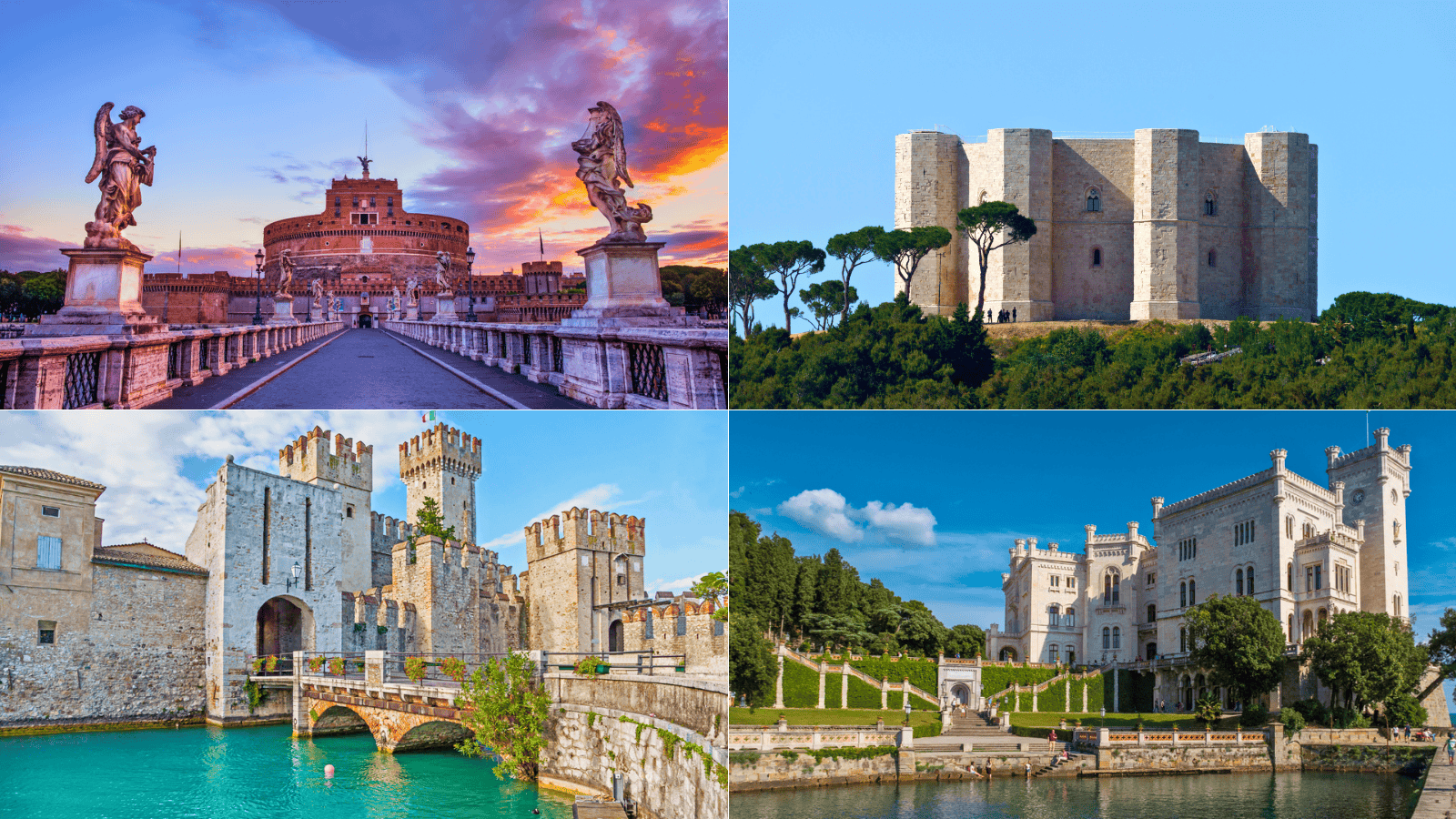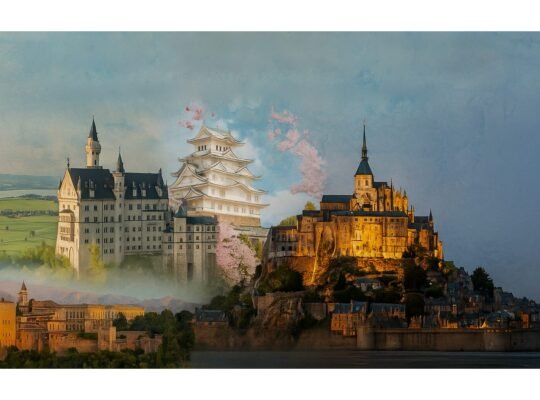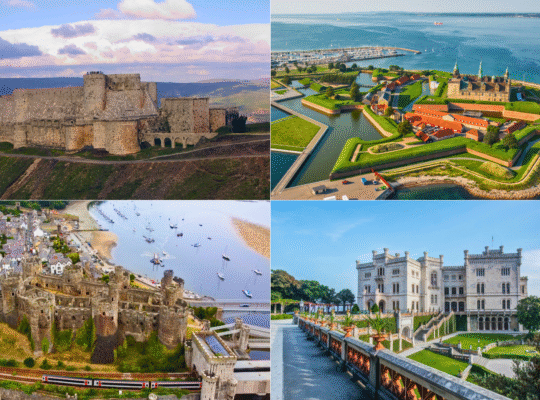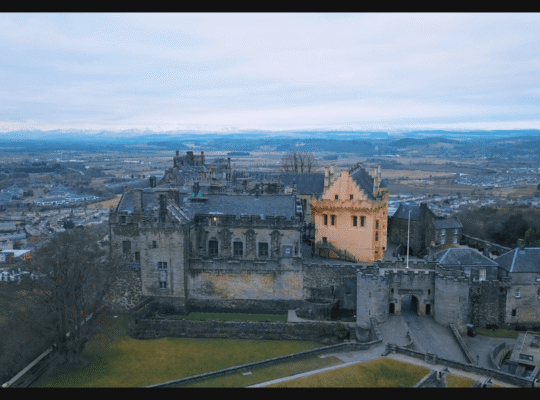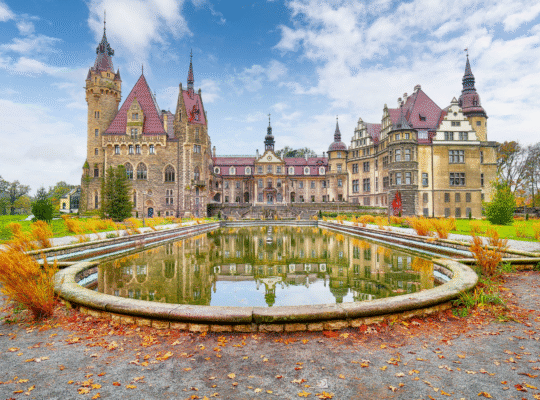I didn’t set out to become a castle person. My first trips to Italy were about food, art, and ticking off the big sights—Rome, Florence, the usual stops. But then I visited a castle by accident. One moment I was following a faded sign on a quiet road in Puglia, the next I was standing in front of stone walls older than half the countries in Europe. I realized right then: Italian castles are some of the country’s most overlooked highlights.
Italy has hundreds of castles, each with its own personality. Some are massive fortresses in city centers; others are almost hidden in quiet countryside or perched on lake shores. Walk through their gates and you’ll find a mix of history, legends, and the kind of odd stories that never make it into the guidebooks.
If you’re planning a trip to Italy, trust me: you’ll want to add at least a few castles to your list. These places aren’t just for history buffs. They’re for anyone who wants to see something real, touch old stone, and step into another world for an afternoon. In this guide, I’ll share ten of the very best castles to visit in Italy—what makes them special, what to look for, and how to get the most out of your visit.
Let’s get started.

Italy’s Top 10 Castles at a Glance
| 🏰 Castle | 📍 Location | 🏗️ Era | 🎭 Famous For | 🎲 Fun Fact / Legend |
|---|---|---|---|---|
| Castel del Monte | Puglia | 13th century | Unique octagonal shape, UNESCO site | Built by Emperor Frederick II—its purpose is still debated |
| Castello Sforzesco | Milan | 15th century | Renaissance stronghold, Da Vinci ties | Once Europe’s largest citadel; Da Vinci painted here |
| Castello Scaligero | Sirmione | 13th century | Moated fortress on Lake Garda | Only water entrance by boat; local ghost legend |
| Castel Sant’Angelo | Rome | 2nd century | Ancient mausoleum, papal fortress | Secret corridor connects to the Vatican |
| Castello di Miramare | Trieste | 19th century | Romantic cliffside palace | Built for Archduke Ferdinand Maximilian—who rarely stayed there |
| Castello Aragonese | Ischia | 15th century | Volcanic island fortress | Tunnels and hidden passageways beneath the castle |
| Castelvecchio | Verona | 14th century | Red brick towers, city museum | Once Verona’s main line of defense |
| Castello Estense | Ferrara | 14th century | Wide moat, dungeons, Este family | Home to infamous poisonings and escapes |
| Castello di Fenis | Aosta Valley | 13th–15th century | Fairytale turrets, painted interiors | Never used for military defense—built to impress |
| Castello di Monteriggioni | Tuscany | 13th century | Walled hilltop village | Cited by Dante in “The Divine Comedy” |

Castel del Monte (Puglia)
Quick Facts
| 📍 Location: | Andria, Puglia, southern Italy |
| 🏗️ Construction Period: | 1240–1250 |
| 🏰 Architectural Style: | Medieval, unique octagonal design |
| 🎭 Famous For: | Geometric mystery, UNESCO World Heritage status |
| 👑 Notable Figures: | Emperor Frederick II |
| 🏆 UNESCO Status: | Yes (designated in 1996) |
| 🌐 Official Website: | https://museipuglia.cultura.gov.it/musei-puglia/castel-del-monte/ |
You don’t expect to find a castle like this in the middle of rural Puglia. Castel del Monte sits alone on a hill, miles from any bustling city or coastline, surrounded by wheat fields and olive groves. Its perfect octagon shape is the first thing you’ll notice—symmetrical, stark, and strangely modern, despite being nearly 800 years old.

First Impressions
Driving up the winding country road, the castle appears suddenly—almost like a mirage. There’s no moat, no drawbridge, no cluster of houses around its walls. Instead, it’s just you, the breeze, and this massive stone puzzle staring back at you. The place feels almost alien, and that’s part of the draw. Walk around it once, and you’ll see there’s no weak side: every face is identical, each corner capped by a matching octagonal tower. No matter which way you look at it, Castel del Monte challenges your sense of what a medieval castle “should” be.
History, Legends & Stories
Commissioned in the 1240s by Holy Roman Emperor Frederick II—one of the most fascinating figures of the Middle Ages—Castel del Monte was never meant for war. Unlike most castles of the era, it wasn’t built for defense, and historians still debate its true purpose. Some say it was a hunting lodge, others claim it was a scientific observatory, a place for philosophical debates, or even a monument to Frederick’s own obsession with mathematics and the universe.
Plenty of legends swirl around the castle’s geometry. The number eight is everywhere: eight sides, eight towers, eight rooms per floor. Some think the design holds secret codes, astronomical meaning, or links to the Knights Templar. The castle’s isolation has only fueled these stories over the centuries.
Design & What to Look For
Step inside and you’ll find two floors of perfectly proportioned rooms arranged around a central courtyard. Light filters in through slim windows and the open central octagon, giving the interior a hushed, almost sacred feel. The original marble and mosaics are long gone, but you’ll see traces of the castle’s former luxury in the carved stone doorways and window frames.
The lack of defensive features—no moat, no arrow slits, just a solid wall of pale stone—makes you wonder what Frederick was really thinking. Stand in the courtyard at midday and you’ll see how the sunlight slices perfectly along the lines of the architecture, creating patterns that seem more intentional the longer you look.
Personal Reflections
The first time I visited, I expected something grand but maybe a little cold. Instead, I found myself wandering slowly, drawn into the mystery of the place. Castel del Monte doesn’t overwhelm you with size or decorations—it pulls you in by making you ask questions. Why did Frederick choose this spot? Why so many eights? Why build a castle that defies almost every rule of its time?
If you like places that make you think—and maybe spark a few debates over dinner—this is your castle.
Legends and Stories
- The Alchemical Fortress: Some say Frederick II, rumored to be interested in alchemy, built the castle as a sort of stone “book,” filled with hidden messages and mystical significance.
- Secret Meetings: Local stories claim secret societies, philosophers, or even heretics gathered here, shielded from prying eyes.
Why It’s in the Top 10
No other castle in Italy—or anywhere else—looks quite like Castel del Monte. Its sheer originality and the centuries of speculation it inspires make it a must-see, not just for history fans, but for anyone who enjoys a good mystery. In 1996, UNESCO named it a World Heritage Site, calling it “a unique masterpiece of medieval architecture.” That recognition isn’t just a label—it’s proof that Castel del Monte’s strange beauty and enigmatic design are valued around the globe.
Practical Tips
- How to Get There: Easiest by car—about 18 km from Andria, 55 km from Bari. There’s a parking lot at the base; shuttle buses take you up the last stretch.
- Entry & Tours: Full entrance ticket €10. Tickets can be booked online or at the entrance. Audio guides and guided tours are available in several languages.
- Opening Hours: Usually open daily, but hours vary by season. Check the official site for current info.
- Accessibility: The approach involves a short walk; interiors have some uneven floors and stairs.
- Tips: Visit early or late in the day to avoid tour groups. Bring water and a hat—Puglia gets hot.
Nearby Attractions
- Trani: A beautiful seaside town with a famous cathedral and harbor.
- Andria: Great for local food (try the burrata cheese).
- Alta Murgia National Park: Rolling hills and hiking trails, perfect for a picnic after your castle visit.

Castello Sforzesco (Milan)
Quick Facts
| 📍 Location: | Milan, Lombardy, northern Italy |
| 🏗️ Construction Period: | Originally 1360s, expanded 1450s |
| 🏰 Architectural Style: | Renaissance military fortress |
| 🎭 Famous For: | Powerful city symbol, museums, Da Vinci’s legacy |
| 👑 Notable Figures: | Francesco Sforza, Leonardo da Vinci, Ludovico il Moro |
| 🏆 UNESCO Status: | Not UNESCO-listed |
| 🌐 Official Website: | www.milanocastello.it |
If you think Milan is all fashion and aperitivo, you haven’t wandered through Castello Sforzesco yet. This enormous red-brick fortress sits right in the heart of the city—just steps from the bustle of the shops and the gleaming spires of the Duomo. There’s something surreal about slipping through its ancient gates and finding yourself surrounded by courtyards, towers, and the kind of walls that once stood against invading armies.

Arrival & First Impressions
The first time I saw Castello Sforzesco, I’d just finished a morning espresso in Piazza del Duomo. I decided to walk “just a little further,” and suddenly this fortress rose up ahead—massive towers, a wide moat (dry now, but easy to imagine full of water), and the kind of ramparts you picture in old battle scenes. Despite its size, the castle somehow manages to feel welcoming. Locals cross the courtyards on their way to work, kids race bicycles along the paths, and street musicians play under the arches.
History, Legends & Stories
Castello Sforzesco began as a defensive fortress for the Visconti family in the 14th century. But it was Francesco Sforza, a shrewd mercenary-turned-duke, who rebuilt and expanded it in the 1450s. Under the Sforza dynasty, the castle became the beating heart of Renaissance Milan—grand enough for royalty, but tough enough to withstand sieges.
This place has seen it all: foreign occupation by the French, Spanish, and Austrians; periods of neglect; even use as army barracks. One of its most famous residents was Leonardo da Vinci, who painted frescoes and designed military defenses here. His fingerprints are all over the castle, if you know where to look.
There’s a persistent legend about a secret tunnel connecting the castle to the city’s historic canals, said to be used for midnight escapes. Another tells of lost Sforza treasures—artworks, coins, even jewels—hidden somewhere in its thick walls, waiting for the right set of eyes to find them.
Design & What to Look For
Architecturally, Castello Sforzesco is a real mash-up: medieval towers, Renaissance halls, defensive bastions, and monumental courtyards. Walk under the Filarete Tower, the castle’s main gate, and you’ll spot Sforza family emblems carved in stone. Don’t miss the Rocchetta (the “little fortress” inside the main one), with its delicate loggias and arcades.
Inside, the castle houses a maze of museums. One highlight: Michelangelo’s unfinished final sculpture, the haunting Rondanini Pietà. There’s also a room painted by Leonardo himself, and collections of armor, musical instruments, and antique furniture.
Personal Reflections
During one afternoon exploring Castello Sforzesco, I found myself zigzagging through echoing corridors, then pausing in a quiet corner where a local artist was sketching the arches. In another wing, school groups chatted their way past centuries-old armor, while a couple sat reading under the shade of a stone arch. What surprised me most was how naturally the old fortress fits into Milan’s daily rhythm—more neighborhood hub than frozen monument. This is a castle where the past and present genuinely mix.
Legends and Stories
- Da Vinci’s Secret Codes: Locals say there are hidden symbols and cryptic drawings by Leonardo scattered throughout the castle, waiting for eagle-eyed visitors to spot them.
- The Ghostly Lady in Black: Some staff claim a veiled woman wanders the halls at night, searching for a lost Sforza prince.
Why It’s in the Top 10
It’s not just the history or the size—it’s the way Castello Sforzesco brings the past into everyday life. This is a castle you can explore at your own pace, one that rewards curiosity, whether you’re here for art, architecture, or just a break from city noise.
Practical Tips
- How to Get There: Easily walkable from Milan’s center; the Cairoli metro stop is right outside the main gate.
- Entry & Tours: The castle courtyards are free. Museums inside require a ticket (available at the entrance or online), usually €3-€5. Guided tours in multiple languages are offered.
- Opening Hours: Open daily, but museum hours vary—check the official website for up-to-date info.
- Accessibility: Main paths are flat, and most museum spaces are accessible.
- Tips: Visit early or late for quieter courtyards. The museum ticket covers multiple exhibits—don’t rush!
Nearby Attractions
- Parco Sempione: Milan’s central park spreads out just behind the castle—great for a stroll or picnic.
- Triennale Milano: Design and art museum inside the park.
- Brera District: Full of art galleries, cafes, and some of Milan’s best shopping, just a short walk away.

Castello Scaligero (Sirmione, Lake Garda)
Quick Facts
| 📍 Location: | Sirmione, Lake Garda, Lombardy |
| 🏗️ Construction Period: | Late 13th century |
| 🏰 Architectural Style: | Medieval fortress, Ghibelline style |
| 🎭 Famous For: | Moated walls, dramatic setting on the lake |
| 👑 Notable Figures: | Scaliger (Della Scala) family |
| 🏆 UNESCO Status: | Not UNESCO-listed |
| 🌐 Official Website: | https://www.visitmalcesine.com/en/the-scaliger-castle-of-malcesine |
If you picture a classic medieval castle rising straight out of sparkling blue water, you’re picturing Castello Scaligero. Guarding the entrance to Sirmione’s peninsula, this fortress looks almost like a movie set. From a distance, its high stone towers and battlements look tough and intimidating—but the closer you get, the more you realize just how perfectly it fits its fairytale setting.
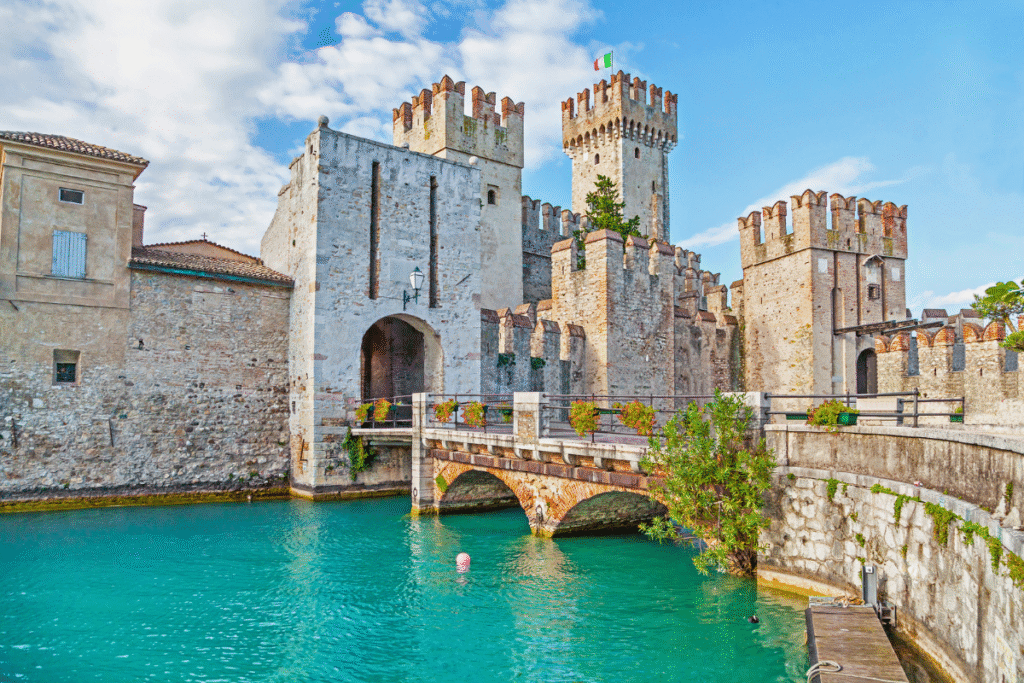
Arrival & First Impressions
Arriving in Sirmione, it’s hard not to stop and stare. The castle literally blocks the only road into the old town, its moat filled with lake water, swans gliding by the drawbridge. You cross over, hearing the slap of water against stone, and suddenly you’re inside a maze of courtyards and towers with Lake Garda glinting all around. It’s one of the only castles in Italy where you arrive by foot, boat, or even paddleboard.
History, Legends & Stories
Built by the Scaliger family, the medieval rulers of Verona, the castle was part fortress, part showpiece—intended to control trade and movement along the lake. Over the centuries, it passed between rulers, saw sieges, and was used as both a prison and a military garrison. There’s no shortage of stories about secret meetings and escapes, and at least one local legend claims there are still hidden treasures somewhere inside the walls.
One of the most persistent tales is the ghost story of Ebengarda, a noblewoman said to haunt the castle after a tragic betrayal. Locals insist that, especially on stormy nights, you can hear her footsteps echoing through the empty halls.
Design & What to Look For
Castello Scaligero is famous for its nearly perfect preservation and its complete moat—unusual for Italy. The water laps right up against the outer walls, giving the whole place a cool, fresh feel, especially on hot summer days. Climb up the main tower for panoramic views: terracotta rooftops on one side, endless blue lake on the other. Walk along the battlements and you’ll get a sense of what it was like to stand guard centuries ago.
Inside, you’ll find a large central courtyard, thick walls, and a series of wooden walkways. There’s a small museum with models and artifacts from the area, and if you’re feeling adventurous, you can even wander the ramparts for one of the best views in northern Italy.
Personal Reflections
Stepping off the boat and seeing Castello Scaligero up close, I realized just how seamlessly it blends into the waterfront. The rush of other visitors faded away the moment I climbed the ramparts. With every step along the old stone walls, I found new angles of Lake Garda—sails glinting in the sun, kids splashing along the shore, swans drifting through the moat. There’s something about the breeze and the ever-changing light here that nudges you to pause, breathe, and watch the scene unfold at its own pace.
Legends and Stories
- The Ghost of Ebengarda: Said to roam the towers searching for her lost love, her story is still told by locals and tour guides.
- Hidden Treasure: There’s a rumor that somewhere inside the walls lies a stash of jewels left behind by fleeing lords.
Why It’s in the Top 10
There are plenty of beautiful castles in Italy, but few have such an iconic setting. Castello Scaligero is the stuff of childhood dreams—moats, towers, hidden staircases, and unbeatable lake views. It’s also extremely accessible and fun to explore for visitors of any age.
Practical Tips
- How to Get There: Sirmione is reachable by car, bus, or ferry from other Lake Garda towns. Parking is outside the old town; from there it’s a short walk.
- Entry & Tours: Tickets (€5-€7) available at the entrance. Guided and self-guided options; museum and ramparts included.
- Opening Hours: Usually open every day, but hours change by season—check the official website.
- Accessibility: The main courtyard is accessible, but towers and walls require stairs.
- Tips: Early mornings and late afternoons are quieter. Bring a camera and don’t skip the climb to the main tower.
Nearby Attractions
- Sirmione Old Town: Charming streets, gelato shops, and boutiques just outside the castle.
- Grotte di Catullo: Ancient Roman villa ruins at the tip of the peninsula.
- Lake Garda: Swimming, boat tours, and lakeside walks—perfect for a relaxing afternoon after exploring the castle.

Castel Sant’Angelo (Rome)
Quick Facts
| 📍 Location: | Rome, Lazio |
| 🏗️ Construction Period: | Begun AD 123–139 |
| 🏰 Architectural Style: | Roman mausoleum turned fortress |
| 🎭 Famous For: | Papal stronghold, secret passage, rooftop views |
| 👑 Notable Figures: | Emperor Hadrian, various Popes |
| 🏆 UNESCO Status: | Part of the Historic Centre of Rome (Designated in 1980) |
| 🌐 Official Website: | https://castelsantangelorome.com/ |
Few places in Rome pack as much history into a single building as Castel Sant’Angelo—a monument recognized as part of the city’s UNESCO World Heritage site. Its inclusion is no accident: this fortress embodies Rome’s ability to reinvent itself across centuries, blending ancient imperial roots with papal intrigue and Renaissance artistry. Walk along the Tiber at sunset and you’ll spot its unmistakable, round silhouette just minutes from the Vatican, crowned by a bronze angel watching over the city. Standing here, you’re not just seeing a famous landmark—you’re experiencing a piece of history the world has chosen to protect for generations to come.

Arrival & First Impressions
Standing on the Ponte Sant’Angelo, with its row of dramatic angel statues, you get one of Rome’s best castle views—especially as the light turns golden in late afternoon. Cross the bridge, step under the fortress walls, and you’re in a space that has seen everything from Roman emperors’ funerals to medieval sieges and secret escapes.
History, Legends & Stories
Originally built by Emperor Hadrian as a mausoleum for himself and his family, the structure became a fortress in the 5th century when Rome needed to defend itself from invading armies. Over the centuries, it transformed again and again: papal residence, military barracks, prison, treasury, and refuge of last resort for the Popes. A hidden fortified corridor, the Passetto di Borgo, still links the Vatican to the castle—a real-life escape route used more than once during troubled times.
Castel Sant’Angelo’s name comes from a legendary vision during a plague in AD 590. Pope Gregory the Great saw the Archangel Michael atop the mausoleum, sheathing his sword as a sign the plague was ending. From that point on, the castle became a symbol of protection for Rome.
Design & What to Look For
The castle’s massive round base and walls are unmistakably Roman, but inside, you’ll find layers upon layers: papal apartments with frescoes, echoing dungeons, weapon displays, and secret stairways. Climb the winding ramp that once carried the emperor’s ashes, and you’ll reach rooftop terraces with jaw-dropping views of St. Peter’s and the city skyline.
Don’t miss the little museum of arms and armor, the elaborate Renaissance rooms used by the Popes, and the tiny, cell-like prison where historical figures—like the sculptor Benvenuto Cellini—were held.
Personal Reflections
What struck me at Castel Sant’Angelo was how each level brings a new layer of history into focus. One hallway echoes with the hush of ancient Rome, while the next opens onto rooms decorated for popes and princes. Reaching the top, I found myself shoulder-to-shoulder with travelers snapping photos of St. Peter’s dome and the river winding through the city. Up there, you realize why so many people linger—Rome looks both timeless and brand new from this height.
Legends and Stories
- The Angel’s Appearance: According to legend, the archangel appeared above the castle and stopped the plague—a story still referenced by the statue that tops the building.
- Secret Escapes: Multiple Popes, including Clement VII, escaped attackers via the Passetto di Borgo—a hidden passage you can still see from the ramparts.
Why It’s in the Top 10
It’s a rare spot where you can walk through nearly 2,000 years of history, from imperial Rome to Renaissance intrigue. Castel Sant’Angelo is as much about the stories as the architecture, and the views from the top are among the best in Italy.
Practical Tips
- How to Get There: Short walk from the Vatican and central Rome; metro stop Lepanto or Ottaviano, then walk 10–15 minutes.
- Entry & Tours: Tickets (from €20) at the entrance or online; audio guides available. The Passetto passage is sometimes open for special guided tours—ask at the ticket desk.
- Opening Hours: Open daily except some holidays; check the official website for current hours.
- Accessibility: There are many stairs and some uneven floors, but much of the main path is accessible.
- Tips: Go in the morning or late afternoon for fewer crowds and the best light for photos.
Nearby Attractions
- St. Peter’s Basilica & Vatican Museums: Just a 10-minute walk away.
- Piazza Navona & Campo de’ Fiori: Lively city squares for a meal or people-watching.
- Tiber River Walks: Great for an evening stroll, especially when the city lights come on.

Castello di Miramare (Trieste)
Quick Facts
| 📍 Location: | Trieste, Friuli Venezia Giulia |
| 🏗️ Construction Period: | 1856–1860 |
| 🏰 Architectural Style: | Romantic, eclectic, Austrian influence |
| 🎭 Famous For: | Clifftop setting above the Adriatic Sea |
| 👑 Notable Figures: | Archduke Ferdinand Maximilian of Austria |
| 🏆 UNESCO Status: | Not UNESCO-listed |
| 🌐 Official Website: | https://miramare.cultura.gov.it/en/ |
You know you’re in for something special the minute you catch sight of Castello di Miramare, gleaming white atop a rocky promontory just outside Trieste. The Adriatic below is impossibly blue, and the castle looks more like a fantasy palace than a military fortress. On a sunny day, it feels like it’s floating between the sea and sky.

Arrival & First Impressions
A tree-lined park surrounds the castle, and there’s a sense of calm as you walk toward the water’s edge. Seagulls glide overhead. The air smells faintly of salt and pine. Whether you arrive by bus, car, or a gentle stroll from the nearby marina, Miramare’s setting is one of the most dramatic in all of Italy. It’s easy to see why the Habsburgs chose this exact spot.
History, Legends & Stories
Castello di Miramare was built for Archduke Ferdinand Maximilian, younger brother of the Austrian emperor. He wanted a home that combined romance and nature—so he designed this castle to face the open sea, with huge windows, sweeping terraces, and a lush park filled with rare plants from around the world. Sadly, Maximilian didn’t enjoy his palace for long. He was sent to Mexico to rule as emperor and was executed there after just a few years. His wife, Charlotte, suffered a mental breakdown and never returned.
Stories persist of Miramare’s “curse”—a rumor that anyone who sleeps in the castle will never return home. Guides and locals mention this with a nervous laugh, but it adds a bit of drama to the bright, elegant halls.
Design & What to Look For
Inside, the castle is surprisingly intimate. The private apartments are filled with original furniture, paintings, and travel souvenirs from the couple’s global adventures. Each room has sweeping views of the bay or the gardens. Look for the wood-paneled study, the delicate tapestries, and the ornate reception rooms that hosted parties for European nobility.
Outside, the 54-acre park is a highlight. Paths wind past ponds, rare trees, and hidden gazebos. There are benches where you can sit and watch the light change on the water, and in spring the whole area bursts into bloom.
Personal Reflections
Exploring Miramare, I was struck by how easily you slip into daydreams. Standing on the balcony, it wasn’t the historical facts that stuck with me—it was the simple act of watching the light dance on the water and picturing the castle as a peaceful retreat. With the breeze coming off the Adriatic and gardens stretching out behind me, it was easy to see why someone would want to build their escape right here, perched above the sea.
Legends and Stories
- The Curse of Miramare: Local lore says that anyone who sleeps under the castle’s roof will meet a sad end or never return home.
- The Ghost of Charlotte: Some say the spirit of Maximilian’s grieving wife lingers in the gardens, still waiting for his return.
Why It’s in the Top 10
Few castles offer such a mix of scenery, story, and atmosphere. Miramare is more than a pretty palace—it’s a place where romance, tragedy, and beauty collide.
Practical Tips
- How to Get There: City bus or short taxi from Trieste’s center. There’s also a pedestrian path along the coast.
- Entry & Tours: Tickets (€15) at the gate or online. Audioguides and guided tours are available.
- Opening Hours: Open year-round; hours vary by season—check the official site.
- Accessibility: The park is easy to navigate; the castle has stairs, but many main rooms are accessible.
- Tips: Take time to walk through the park before or after your castle tour. Sunsets here are unforgettable.
Nearby Attractions
- Trieste City Center: Coffee culture, beautiful squares, and the famous Piazza Unità d’Italia.
- Grotta Gigante: One of the world’s largest show caves, just a short drive away.
- Coastal Walks: Enjoy the beaches and scenic trails stretching along the Adriatic.

Castello Aragonese (Ischia)
Quick Facts
| 📍 Location: | Ischia, Bay of Naples, Campania |
| 🏗️ Construction Period: | Original fortification 5th century BC, current structure 1441 |
| 🏰 Architectural Style: | Medieval fortress with Renaissance additions |
| 🎭 Famous For: | Volcanic island setting, panoramic sea views |
| 👑 Notable Figures: | Alfonso V of Aragon, Vittoria Colonna |
| 🏆 UNESCO Status: | Not UNESCO-listed |
| 🌐 Official Website: | www.castelloaragoneseischia.com |
On a small rocky islet off the coast of Ischia, Castello Aragonese rises above the waves like something out of a pirate story. Connected to the main island by a narrow stone causeway, this castle has watched over the Bay of Naples for centuries—its walls battered by storms, eruptions, and more than a few sieges.

Arrival & First Impressions
Crossing the causeway on foot, you can feel the wind and smell the salt air. The sea sparkles below, and the castle’s ramparts loom ahead, inviting you to leave the modern world behind for a few hours. Once inside, you climb through tunnels and winding stairways, emerging into sunlit courtyards, gardens, and crumbling chapels with jaw-dropping views in every direction.
History, Legends & Stories
The site has been fortified since ancient times, but the Aragonese castle we see today began with Alfonso V of Aragon, who rebuilt the stronghold in 1441 to fend off pirates and rival kingdoms. Over the centuries, it became a mini-city: home to nobles, soldiers, monks, nuns, and even regular townsfolk seeking shelter from attacks. In its heyday, there were 13 churches, a convent, prison cells, and lush vineyards. The poet Vittoria Colonna, one of the Renaissance’s most celebrated women, lived here and hosted salons of artists and thinkers.
Legends abound of hidden tunnels beneath the castle, some rumored to reach as far as Naples. Locals tell stories of ghostly monks wandering the cloisters at night and of treasure buried deep in the volcanic rock.
Design & What to Look For
Castello Aragonese is less about ornate rooms and more about dramatic spaces and views. Wander through the maze of passageways and you’ll find ruined churches, a cemetery of nuns with haunting frescoes, olive groves, and secret gardens perched over the sea. The terrace at the top offers a 360-degree panorama of Ischia, Capri, and the distant mainland.
Don’t miss the tiny Museum of Torture (strange but real), or the little cafés hidden among the old walls—perfect for a cold lemonade on a hot day.
Personal Reflections
My visit felt like stepping into another world—part medieval adventure, part sun-soaked escape. I lost track of time climbing the towers, peering into shadowy chapels, and just soaking up the breeze with the sea stretching out on all sides.
Legends and Stories
- The Nun’s Curse: The old convent cemetery is said to be haunted by nuns who still keep watch over their resting place.
- Secret Passages: Guides love to point out sealed doorways that hint at forgotten tunnels and daring escapes.
Why It’s in the Top 10
There’s nowhere else in Italy quite like Castello Aragonese—equal parts fortress, ruin, garden, and lookout. The views alone are worth the journey, but the sense of layered history makes this a true standout.
Practical Tips
- How to Get There: Frequent ferries from Naples to Ischia. From Ischia Porto, take a local bus or taxi to the castle, then walk across the causeway.
- Entry & Tours: Tickets (€12) at the entrance. Guided tours are available.
- Opening Hours: Open daily, but hours vary by season and weather—see the official website.
- Accessibility: Lots of stairs, uneven ground, and tunnels—good walking shoes are a must.
- Tips: Go early or late to avoid crowds and heat. Bring water, especially in summer.
Nearby Attractions
- Ischia Ponte: A charming old fishing village with local restaurants and gelato shops.
- Negombo and Poseidon Thermal Parks: Famous for hot springs and beach clubs.
- Boat Tours: Circle the island for hidden coves and dramatic coastal views.

Castelvecchio (Verona)
Quick Facts
| 📍 Location: | Verona, Veneto |
| 🏗️ Construction Period: | 1354–1376 |
| 🏰 Architectural Style: | Medieval military fortress |
| 🎭 Famous For: | Massive brick walls, museum, river bridge |
| 👑 Notable Figures: | Cangrande II della Scala, the Scaliger dynasty |
| 🏆 UNESCO Status: | Part of Verona’s UNESCO-listed historic center (designated in 2000) |
| 🌐 Official Website: | museodicastelvecchio.comune.verona.it |
If you’ve ever crossed the Adige River in Verona and seen a fortress with fierce battlements and a bold red brick bridge stretching across the water, you’ve found Castelvecchio. Recognized as part of Verona’s UNESCO World Heritage site, this “Old Castle” might sound plain, but step inside and you’ll find one of Italy’s best examples of medieval muscle, artfully mixed with Renaissance elegance.

Arrival & First Impressions
It’s hard to miss Castelvecchio’s thick, crenellated walls and imposing towers—they still look ready for a siege. Step through the main gate and you’ll find yourself in a huge central courtyard, surrounded by solid ramparts. From the first moment, you sense this was built for defense, not luxury.
But there’s a surprise: despite the fortress feel, Castelvecchio is filled with art and beauty. These days, it’s home to Verona’s best museum, but centuries ago, it was all about power and protection.
History, Legends & Stories
Cangrande II della Scala, Verona’s ruler in the 14th century, ordered Castelvecchio built to keep the city safe—and keep an escape route open, just in case. The Ponte Scaligero, the castle’s famous bridge, was his getaway over the Adige. For a while, the fortress was practically a city within a city: soldiers, nobles, arms, and supplies were all kept here, especially when the threat of enemy attack loomed.
After centuries of sieges, Napoleonic occupation, Austrian control, and World War II damage, Castelvecchio emerged as a museum in the 20th century, restored by architect Carlo Scarpa with a masterful blend of old and new.
Stories swirl about secret passages hidden under the bridge, nighttime escapes, and treasures hidden during wartime. There’s even talk of a restless spirit—the “White Lady”—spotted on foggy evenings along the battlements.
Design & What to Look For
Castelvecchio’s defining feature is its blend of military grit and elegant restoration. You’ll walk past arrow slits and drawbridges, then into galleries filled with Renaissance paintings, ancient weapons, and medieval sculpture. The walls and towers are dotted with architectural details—the Scarpa restoration stands out for its beautiful steel walkways and clever lighting.
Don’t miss the panoramic walk atop the castle walls or the view from Ponte Scaligero, especially at sunset when the river glows beneath you.
Personal Reflections
Wandering through Castelvecchio, I found myself pausing at the battlements far more often than I expected. The museum is a treasure, but honestly, it was the sweeping view over Verona—the bridges, rooftops, and slow-moving river—that made the place feel unforgettable. It’s one thing to see art on the walls; it’s another to realize you’re standing above the same streets and water that shaped Shakespeare’s legendary city.
Legends and Stories
- The White Lady: Some say she’s the ghost of a noblewoman imprisoned in the castle, still waiting for justice.
- Cangrande’s Secret Escape: The legendary bridge was built so the ruler could flee in a hurry if things went bad in Verona.
Why It’s in the Top 10
Few places combine fortress drama and artistic treasures like Castelvecchio. It’s a must for history lovers, art fans, and anyone who likes their sightseeing with a little edge.
Practical Tips
- How to Get There: A short walk from Verona’s center, along Corso Cavour.
- Entry & Tours: Tickets (€9) at the entrance or online; audioguides available in several languages.
- Opening Hours: Open Tuesday to Sunday; closed Mondays. Check the official site for details.
- Accessibility: Many galleries are accessible, but the wall walkways involve stairs.
- Tips: Allow extra time for the bridge—great for photos. Early mornings and late afternoons are quietest.
Nearby Attractions
- Piazza Bra & the Arena di Verona: Ancient Roman amphitheater just a short stroll away.
- Juliet’s House: For a dash of Shakespearean romance.
- Adige Riverwalks: Perfect for a relaxing stroll or picnic by the water.

Castello Estense (Ferrara)
Quick Facts
| 📍 Location: | Ferrara, Emilia-Romagna |
| 🏗️ Construction Period: | 1385–16th century (expanded and remodeled) |
| 🏰 Architectural Style: | Medieval fortress with Renaissance palace features |
| 🎭 Famous For: | Wide moat, dungeons, Este family history |
| 👑 Notable Figures: | House of Este, Lucrezia Borgia |
| 🏆 UNESCO Status: | Part of Ferrara’s UNESCO-listed city center (designated in 1995) |
| 🌐 Official Website: | www.castelloestense.it |
Right in the middle of Ferrara, surrounded by busy streets and city life, sits Castello Estense—a castle that looks as if it’s floated straight out of a storybook. Recognized as part of Ferrara’s UNESCO World Heritage site, it’s surrounded by a wide, green moat with four mighty towers—impossible to ignore or mistake for anything else. Locals pass by every day, but step inside and you enter a world of intrigue, drama, and splendor.

Arrival & First Impressions
From the first glimpse, Castello Estense feels imposing and theatrical. Cross one of the brick bridges over the moat and you’ll hear the echo of your footsteps under stone archways. The smell of damp stone and ancient wood lingers in the cool corridors. You’ll see ducks paddling in the moat and city cyclists zipping past the walls outside—a real blend of old and new.
History, Legends & Stories
Built in 1385 after a violent uprising, the castle was meant to keep the Este family safe from their own citizens. Over time, its role shifted from fortress to grand residence. The Este family transformed it with elegant apartments, courtyards, and loggias, filling the rooms with art and hosting some of the Renaissance’s most colorful figures—including Lucrezia Borgia, who married into the family and brought her own notoriety.
The castle is also famous for its dark side. The dungeons beneath the towers saw political prisoners, secret lovers, and traitors. One infamous tale tells of Ugo and Parisina, star-crossed lovers whose tragic end still haunts the thick stone walls.
Design & What to Look For
Castello Estense’s exterior is pure fortress—towers, battlements, and that classic moat. Inside, it’s surprisingly refined: painted ceilings, airy halls, and grand staircases. Visit the dungeons and you’ll feel the chill of history, while upstairs, the golden frescoes and bright windows hint at the castle’s later life as a Renaissance palace.
The Torre dei Leoni, one of the towers, is open for visitors; climb to the top for sweeping views of Ferrara’s rooftops and the countryside beyond.
Personal Reflections
What stuck with me most was the contrast: standing in a dungeon reading about doomed lovers, then walking upstairs into a sunlit hall decorated with mythological scenes. The whole place feels layered—equal parts grim and glorious.
Legends and Stories
- The Lovers’ Tragedy: Parisina and Ugo, caught in a forbidden affair, were executed by the Duke in 1425. Their ghosts are said to wander the dungeons still.
- The Este Poisonings: Rumors abound of family rivals eliminated through secret poisonings at grand banquets.
Why It’s in the Top 10
Castello Estense is everything you want in an Italian castle: a real moat, legendary drama, elegant rooms, and a central spot that makes visiting easy. Its stories linger with you long after you leave.
Practical Tips
- How to Get There: In Ferrara’s city center, walkable from the train station (about 20 minutes) or a quick local bus ride.
- Entry & Tours: Tickets (€12) are available at the entrance or online; guided tours and audio guides are also available.
- Opening Hours: Open daily except some holidays; hours on the official site.
- Accessibility: The main floors are accessible, but the towers and dungeons involve stairs.
- Tips: Visit in the morning for quieter halls. Don’t skip the tower climb for photos.
Nearby Attractions
- Ferrara Cathedral: Stunning Romanesque and Gothic church just steps away.
- Palazzo dei Diamanti: Art gallery with a distinctive diamond-shaped façade.
- Medieval Streets: Ferrara’s old center is a UNESCO site and perfect for wandering or cycling.

Castello di Fenis (Aosta Valley)
Quick Facts
| 📍 Location: | Fenis, Aosta Valley, northwestern Italy |
| 🏗️ Construction Period: | 13th–15th centuries |
| 🏰 Architectural Style: | Medieval, fairytale fortress |
| 🎭 Famous For: | Imposing turrets, inner courtyards, painted interiors |
| 👑 Notable Figures: | Challant family |
| 🏆 UNESCO Status: | Not UNESCO-listed |
| 🌐 Official Website: | https://valledaostaheritage.com/en/chateau-de-fenis/ |
Nestled among Alpine foothills, Castello di Fenis looks exactly like the kind of castle you’d draw as a kid—towers, battlements, and two rings of sturdy stone walls. Unlike many defensive castles, Fenis wasn’t built for war; it was a showpiece of power, built to impress visitors and remind locals who was in charge.

Arrival & First Impressions
Approaching Fenis, you’ll see the towers rising above fields and forests, the mountains looming in the distance. Cross the short path from the parking lot and you’re at the gate, with high walls and pointy turrets inviting you to step into another time. The castle’s setting feels peaceful, almost storybook-like, and is especially atmospheric in the mist or with snow on the peaks.
History, Legends & Stories
Fenis Castle was owned by the powerful Challant family, who ruled much of the region. Instead of battle scars, its history is marked by expansion and embellishment. The castle’s main role was to display the family’s wealth and status, with elegant frescoes and grand reception halls for important guests.
There’s a famous local legend about a hidden treasure buried within the walls by a desperate nobleman. Another tells of secret messages painted into the castle’s frescoes—coded warnings or mystical symbols waiting to be uncovered.
Design & What to Look For
Castello di Fenis is famous for its concentric walls and photogenic silhouette. Step through the main gate and you’re in the inner courtyard, decorated with a beautiful stone staircase and vivid 15th-century frescoes of saints and scenes from daily life. The living quarters are smaller and more practical than in most grand palaces, but the details—painted ceilings, carved fireplaces—are full of character.
Climb the towers for views over the valley and explore the various rooms, from the old kitchen to the chapel with its ornate paintings.
Personal Reflections
My favorite part was standing in the inner courtyard, looking up at the spiral staircase and painted saints. It felt oddly cozy and intimate, more like a fortified home than a military base. Kids especially seem to love this castle—it’s easy to imagine knights, banquets, and secret plots around every corner.
Legends and Stories
- Hidden Treasure: Rumors say a noble once hid his fortune in the castle’s walls to escape enemy hands.
- Fresco Mysteries: Some believe that symbols painted in the frescoes contain clues to ancient secrets or warnings.
Why It’s in the Top 10
Fenis offers a perfect fairytale experience without the crowds of Italy’s bigger sites. It’s a photogenic, family-friendly stop in one of Italy’s most beautiful regions, and the castle’s unique design sets it apart from its more battle-worn cousins.
Practical Tips
- How to Get There: Aosta Valley is best reached by car. Fenis is about 15 km from Aosta town; follow signs and park nearby.
- Entry & Tours: Guided tours required (included in ticket, multiple languages available). Tickets (€10) at the gate or the official website.
- Opening Hours: Open year-round, with shorter hours in winter—check the official site for details.
- Accessibility: Some stairs and uneven ground; the courtyard is accessible for most visitors.
- Tips: The castle can be chilly inside—bring a jacket, even in summer.
Nearby Attractions
- Aosta: Charming Roman town with ancient ruins and lively markets.
- Castello di Issogne & Castello di Verrès: Two other impressive castles in the valley, both with dramatic settings.
- Gran Paradiso National Park: Great for hiking, wildlife, and mountain views after your castle visit.

Castello di Monteriggioni (Tuscany)
Quick Facts
| 📍 Location: | Monteriggioni, Tuscany (near Siena) |
| 🏗️ Construction Period: | Early 13th century (1214–1219) |
| 🏰 Architectural Style: | Medieval walled hilltop fortress |
| 🎭 Famous For: | Complete circular walls with 14 towers |
| 👑 Notable Figures: | Republic of Siena, referenced by Dante Alighieri |
| 🏆 UNESCO Status: | Not UNESCO-listed |
| 🌐 Official Website: | www.monteriggioniturismo.it |
If you’ve ever driven through the Tuscan hills and spotted a perfect crown of stone rising above the fields, you’ve glimpsed Monteriggioni. Unlike most castles, this one is a full village enclosed in its original medieval walls, with 14 towers still standing guard, just as they did centuries ago.
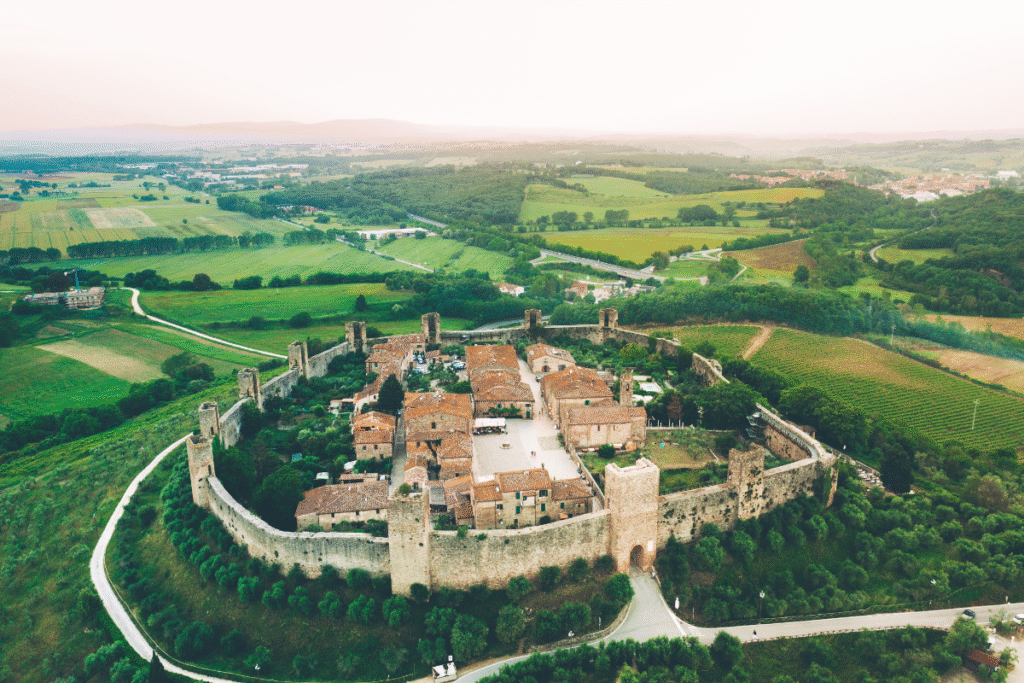
Arrival & First Impressions
You reach Monteriggioni by winding country road, with olive groves and vineyards all around. Suddenly the walls appear, ringed with tall, square towers—like something lifted out of a movie. Step through the main gate and you’re inside a tiny world: stone houses, a central piazza, and quiet lanes with flowers spilling from window boxes.
It’s more peaceful than most tourist stops. You’ll hear church bells, distant laughter from a café, and maybe a few footsteps on the ancient cobbles. The towers watch over everything, just as they have since the days of knights and rival city-states.
History, Legends & Stories
Monteriggioni was built by the Republic of Siena as a military outpost to guard against Florence. For centuries, it was a fortress on the frontline, surviving sieges, betrayals, and political intrigue. The village is so iconic that Dante even referenced its towers in his “Divine Comedy,” comparing them to giants ringing the edge of Hell.
Local legend claims the villagers once tricked attacking Florentine troops by parading every inhabitant—old, young, and even livestock—along the walls to look more numerous and fierce. The ruse worked; the enemy retreated without a fight.
Design & What to Look For
The main highlight here is the wall itself. Walk the ramparts (sections are open to visitors) for a sweeping view of the Tuscan landscape—rolling hills, distant farmhouses, and the same fields medieval soldiers once scanned for enemies.
Inside the village, explore the little piazza, visit the Church of Santa Maria, and peek into the small museums about medieval arms and armor. Every building feels like a piece of living history, and some even house shops or cafés today.
Personal Reflections
I wandered Monteriggioni on a warm afternoon, gelato in hand, and felt as if time had stopped. Unlike many “tourist villages,” people actually live here—it’s a real community, not just a stage set. Kids played soccer near the old walls, while locals chatted in the shade. It’s the kind of place you could linger for hours, soaking in the views and slow pace.
Legends and Stories
- The Disappearing Gate: A local tale insists that, in desperate times, villagers could seal off the main gate so completely that even enemy spies couldn’t find it.
- Dante’s Giants: The castle’s towers are immortalized by Dante, who saw them as the giants guarding Hell in his masterpiece.
Why It’s in the Top 10
Monteriggioni is unique: a living medieval village still enclosed in its original fortress walls. It offers the classic Tuscan atmosphere, fascinating history, and a sense of place you won’t find anywhere else.
Practical Tips
- How to Get There: Best reached by car (short drive from Siena); limited bus service from Siena also available.
- Entry & Tours: You can enter the village for free; small fee (€5) to walk the walls. Two short museums on medieval arms and local history.
- Opening Hours: The walls and museums have set hours—check the official site for current info.
- Accessibility: The main piazza and most streets are accessible; wall walks involve stairs.
- Tips: Visit in the early morning or late afternoon for the most peaceful atmosphere. The annual medieval festival (usually July) is especially fun.
Nearby Attractions
- Siena: One of Italy’s most beautiful cities, just a 20-minute drive away.
- Chianti Wine Region: Rolling hills and famous vineyards nearby.
- San Gimignano: The famous “medieval Manhattan,” known for its own towers, is a short trip away.

Which Castle Is Best for You? Planning Your Italian Castle Adventure
With so many incredible options, picking which castles to visit in Italy can feel overwhelming—especially if your time is limited or you’re traveling with family, friends, or a partner. Here’s a quick guide to help you match your interests and travel style to the right castles, plus tips on combining a few into one unforgettable trip.
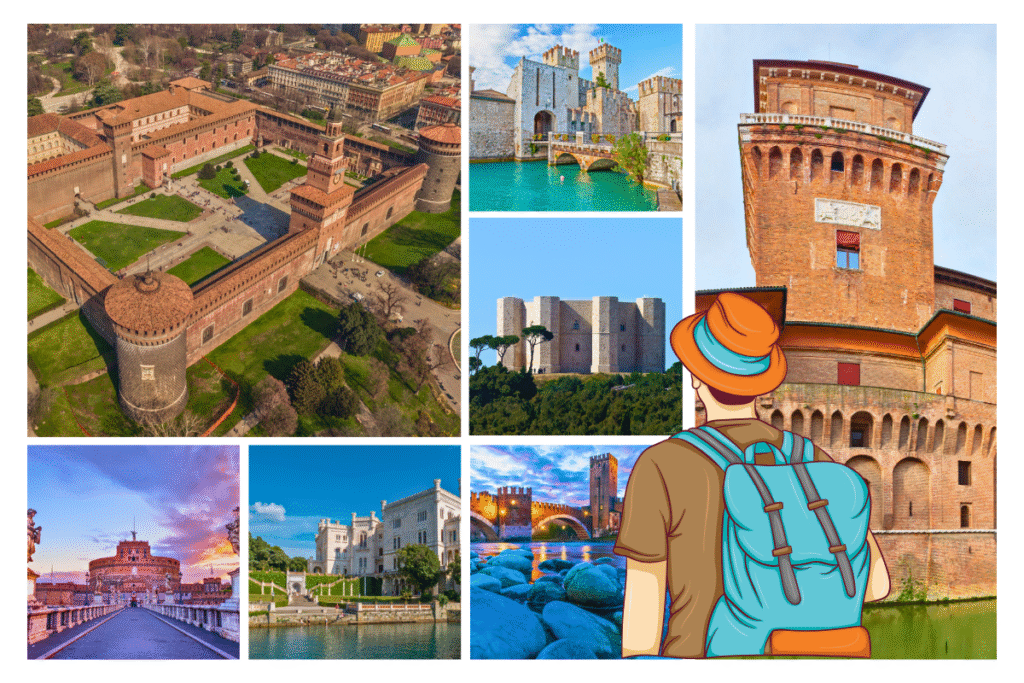
Quick Picks: Find Your Perfect Italian Castle
For Families and Kids:
- Castelvecchio (Verona): Lots of space to roam, cool towers and bridges, and a museum with armor and medieval weapons that even kids find fun.
- Castello di Fenis (Aosta Valley): Fairytale towers and a manageable size make it ideal for young explorers.
For Romantic Getaways:
- Castello di Miramare (Trieste): Stunning sea views, elegant rooms, and beautiful gardens—perfect for couples.
- Castello Aragonese (Ischia): Dramatic coastal sunsets, island breezes, and secret gardens. Bring a camera.
For History Lovers:
- Castel Sant’Angelo (Rome): Layer upon layer of Roman, medieval, and Renaissance intrigue.
- Castello Estense (Ferrara): A real moat, dungeons, and the tangled stories of the Este family.
For Architectural Wonders:
- Castel del Monte (Puglia): Unique octagonal design that’s unlike anything else in Italy.
- Castello Scaligero (Sirmione): The only Italian castle surrounded by a water moat, set right on Lake Garda.
For Photographers & Instagrammers:
- Monteriggioni (Tuscany): Iconic towers ringed by green hills, golden light, and dramatic skies.
- Castello di Miramare (Trieste): Best at sunset or sunrise, with the sea sparkling in the background.
For Off-the-Beaten-Path or Hidden Gems:
- Castello di Fenis (Aosta Valley): Less crowded and set in the stunning Alps.
- Castello Aragonese (Ischia): Fewer tourists than mainland castles and a truly unique island vibe.
How to Combine Castles: Sample Routes and Itineraries
Northern Italy Adventure:
- Start in Milan (Castello Sforzesco), head east to Lake Garda (Castello Scaligero), then continue to Verona (Castelvecchio) and finish in Trieste (Castello di Miramare). Perfect for a one-week road trip with plenty of cities, lakes, and scenery.
Tuscan & Central Italy Road Trip:
- Base yourself in Siena and visit Monteriggioni, then swing north to Aosta Valley (Castello di Fenis) for mountain air and Alpine castles. Round it out with a stop in Ferrara (Castello Estense) for Renaissance grandeur.
Southern Italy & Islands Escape:
- Start in Rome (Castel Sant’Angelo), then train or drive down to Puglia (Castel del Monte), and ferry across to Ischia (Castello Aragonese). Perfect for travelers who want history, sunshine, and sea breezes.
Short on Time?
- Combine Castel Sant’Angelo and Castello Sforzesco for a city-and-culture trip with easy train connections between Rome and Milan.
- Or focus on one region: spend a day in Verona (Castelvecchio) and Lake Garda (Castello Scaligero), both easy to reach and great for all ages.
Tips for Planning Your Castle Itinerary
- Book tickets ahead (especially in summer) for popular sites.
- Check opening hours—they change by season and region.
- Wear comfortable shoes; many castles have steep stairs or uneven ground.
- Allow extra time to relax and soak in the atmosphere—some of the best moments are just sitting on a wall or enjoying a picnic in a castle garden.
- Mix it up: Pair city castles with rural or coastal ones to get a real feel for Italy’s diversity.
No matter which castles you choose, you’ll leave with a camera full of epic photos and at least one new story to tell.

Final Thoughts: Why Italy’s Castles Leave a Lasting Mark
After traveling from the Alps to the southern coast, I can say there’s nothing quite like exploring Italy through its castles. Each one has its own personality—some are wild and dramatic, perched above crashing waves; others are peaceful and sun-baked, hidden in rolling hills or bustling city centers. But all of them offer a direct line to the past and a way to see Italy that goes beyond the classic tourist checklist.
What sticks with me the most? It’s the mix of stories and small moments. The echo of footsteps on stone stairs, the breeze off Lake Garda as you look out from a battlement, or the chatter of locals who walk these castle courtyards every day. It’s sharing a gelato under medieval walls, tracing your hand along carved stone, or standing in the same room where dukes, artists, and even emperors once planned their next move.
If you love discovering places that are both beautiful and full of character, put at least one or two of these castles on your next Italy itinerary. Even just a single afternoon spent wandering the towers or gardens can turn a good trip into an unforgettable one.
I’d love to hear from you: Which Italian castles have you visited, or which are on your wish list? Did you find a hidden spot or have a surprising moment along the way? Share your story in the comments 💬 below, or tag 👻 your adventures with us @CastleQuestChronicles on Instagram. Your best discoveries might inspire someone else to plan their own Italian castle adventure.
👉 Love castles as much as we do? Don’t miss our guides to the best castles in Germany, England, and France. There’s always another wall to walk, another legend to chase.
Happy exploring—and see you at the next castle!
📸 And if this article sparked your curiosity about the castles, follow along. We are on Instagram, Pinterest, Facebook, and X, too. More castles (and more stories) are just around the bend. Explore all our castle adventures here!

